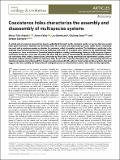Coexistence holes characterize the assembly and disassembly of multispecies systems
Author(s)
Angulo, Marco Tulio; Kelley, Aaron; Montejano, Luis; Song, Chuliang; Saavedra, Serguei
DownloadAccepted version (2.339Mb)
Publisher Policy
Publisher Policy
Article is made available in accordance with the publisher's policy and may be subject to US copyright law. Please refer to the publisher's site for terms of use.
Terms of use
Metadata
Show full item recordAbstract
A central goal of ecological research has been to understand the limits on the maximum number of species that can coexist under given constraints. However, we know little about the assembly and disassembly processes under which a community can reach such a maximum number, or whether this number is in fact attainable in practice. This limitation is partly due to the challenge of performing experimental work and partly due to the lack of a formalism under which one can systematically study such processes. Here, we introduce a formalism based on algebraic topology and homology theory to study the space of species coexistence formed by a given pool of species. We show that this space is characterized by ubiquitous discontinuities that we call coexistence holes (that is, empty spaces surrounded by filled space). Using theoretical and experimental systems, we provide direct evidence showing that these coexistence holes do not occur arbitrarily-their diversity is constrained by the internal structure of species interactions and their frequency can be explained by the external factors acting on these systems. Our work suggests that the assembly and disassembly of ecological systems is a discontinuous process that tends to obey regularities.
Date issued
2021-05Department
Massachusetts Institute of Technology. Department of Civil and Environmental EngineeringJournal
Nature Ecology & Evolution
Publisher
Springer Science and Business Media LLC
Citation
Angulo, M.T., Kelley, A., Montejano, L. et al. Coexistence holes characterize the assembly and disassembly of multispecies systems. Nat Ecol Evol 5, 1091–1101 (2021).
Version: Author's final manuscript
ISSN
2397-334X